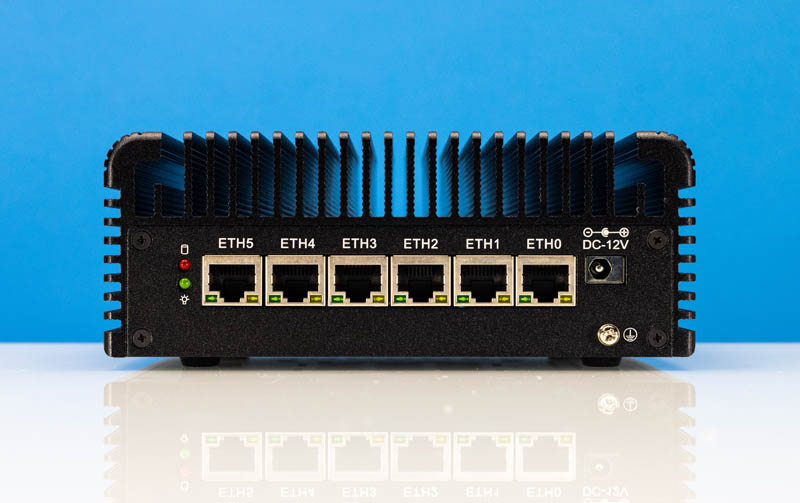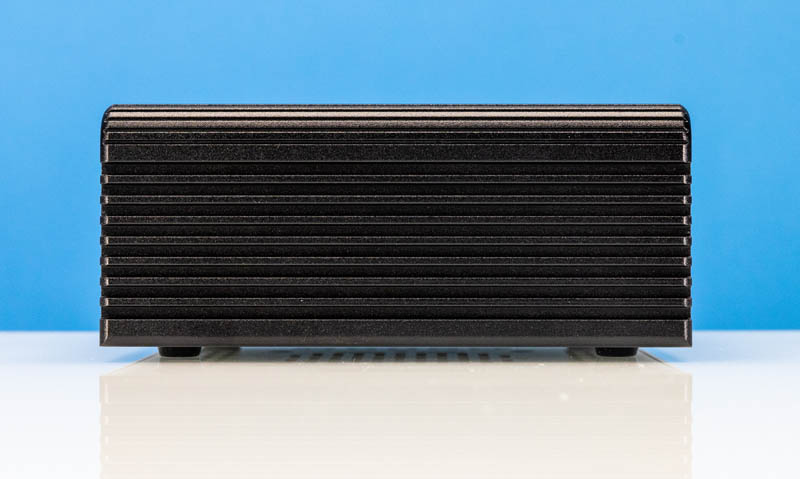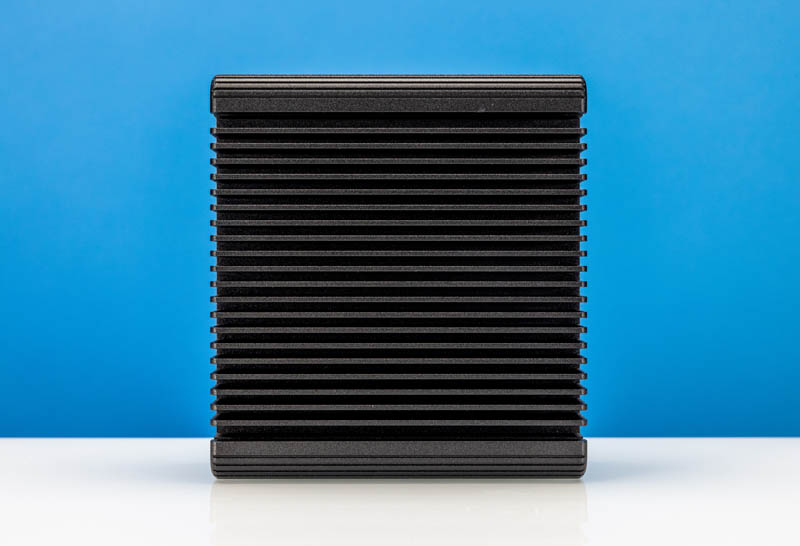What do you get when you combine the Intel Alder Lake’s heterogeneous core architecture into a 15W design with 6x 2.5GbE NICs? Something very cool. We are calling this the “King” of the fanless units we have tested. While it is more costly, it is also significantly faster. At the same time, it is temperamental with plenty of frustrating quirks that STH readers and our team have had to work through.
The King Fanless Intel Core i5 6x 2.5GbE CWWK System Overview
For the “King”, we had to do a video that you can find here:
As always, we suggest opening this in its own browser, tab, or app for the best viewing experience.
First off, we need to get to what we purchased, and why. The unit we purchased is a 12th Gen Intel Alder Lake series fanless desktop, firewall, and virtualization host from CWWK. Here is the link (Affiliate link.)

We purchased the unit with the Intel Core i5-1235U which costs $465 or so barebones, depending on the coupons and discounts that day. Other storefronts like Topton and Kingnovy are reselling this CWWK unit.
We also purchased the 16GB and 512GB configurations. Memory compatibility can be rough on these little boxes, and we just wanted to see what we would get. Something we have found with this unit, and also the AMD Ryzen 4x 2.5GbE Firewall Router is that they often come with BIOS Windows 11 Pro keys. Windows Activation found the digital license on the system and activated Windows 11 Pro.

The Intel Core i5-1235U we believe is a sweet spot. It is about $160 less than the Core i7 version that has the same core counts, albeit with higher clocks. Usually in these fanless boxes, we are cooling and power-constrained so extra clock speed is lost fairly quickly due to throttling. The Core i5-1235U has two P-cores with hyper-threading and eight E-cores just like the Core i7-1256U. The Core i3-1215U has half of the E-cores and a lower-end integrated GPU. The Pentium Gold 8505 has only a single P-core. If you are looking for a performance upgrade over the N6005 and N100 systems out there, then the Gold 8505 is going to be priced closer with more performance. We are instead looking at about twice the compute for $170 more.

We did not get a WiFi option but will cover a bit on installing that aftermarket. That feels like one of the big misses. Otherwise, having 6x 2.5GbE is fairly massive in a system like this.
As a quick note here, in the STH forums, there is an awesome thread on these with BIOS tweaks, hardware hacks, how to get things working, and more. If you purchase these and intend to do anything outside of running a stock system, then you will want to bookmark that thread.
Next, let us get to our hardware overview.
The King Fanless Intel Core i5 6x 2.5GbE CWWK System External Hardware Overview
Looking at the outside of the system, we get a power button, a clear CMOS button, and a TF (microSD) card slot. There are three display outputs. We get one HDMI port, one DisplayPort, and then the Type-C can have DP alt mode support. Aside from that USB Type-C port, there are four Type-A ports half Gen1 and half Gen2. For a small fanless desktop, this is a fairly good solution, but you will not find Thunderbolt on this unit.

One will note the two WiFi antenna hole plugs on either side. We used these when mounting WiFi antennas to this unit.
On the other side, we have our status lights, grounding point, and 12V DC input. The big feature is networking. Here we have 6x Intel i226-V network ports.

This is a fanless system. As such, there are large fins on top of the chassis and even fins on the side.

The top is not overly exciting except it does not have a fan.

The bottom has large cooling vents and mounting points for a VESA mount that we did not get with our unit.

Something we will note here is that the bottom of the system has a lot going on. We were recommended an 80x80x10mm fan to cool the bottom of the system, but we did not get one with our unit. That may vary based on the seller.
Next, let us get inside the unit to see what is going on.





No testing of the max network throughput? It has six NICs so I’m sure folks are curious. I’m not expecting line rate but it’d be good to know where the ceiling is.
Huh? The N6005’s with four older E cores do line rate on 2.5GbE NICs if you’ve got dual ch mem installed. This is much faster than that.
Even with 64kB packets? All 6 NICs forwarding traffic at 2.5Gbps all at once? Maybe I’m just out of touch with what these CPUs are capable of.
“Something very cool.”
I see what you did there. Have an upvote.
vPRO Enterprise would make it really interesting.
You keep implying that the higher i7 variants won’t be worthwhile on TDP/heat limited designs, because they’ll just be throttled anyway… effectively killing the frequency advantage.
Sure, there will be diminishing returns, but as with all these mobile parts, in this case with the i5-1235U and the i7-1265U there, will still be a significant performance difference–at the very same TDP or heat point.
The difference between the two is no longer just Intel cutting certain fuses to provide a spread for every niche in the market (not that that’s gone away completely). At least part of it is really just binning and that’s really rather analog these days and not just about transistors working or not or chips failing to function beyond a certain speed.
While that can obviously happen, binning is mostly about the quality and impedance of wire-transistor interconnects and how they’ll require a bit more voltage (or not) to push signals at a given frequency. And of course, higher voltages imply higher power consumption, which also has chips failing eventually, but it’s the power budget that seems to be the more significant hurdle for binning.
E.g. in Skylake/Kaby-Lake times hyperthreading wasn’t cut for some bins because some transistors weren’t working, but mostly because it helped keeping the power budget in check. Real chip defects on the other hands could “crater” cache SRAM banks or full cores, so these i3-1215U could really be that type of salvaged chips—or require 30 Watts to run with fully enabled cores: too high to sell in a mobile space for 2P performance.
A lot of these i5-1235 might have no issue reaching “i7-1265 frequencies” or in fact higher yet, but they’d get hotter in comparison and at a certain point too hot for the platform constraints.
So on a mobile platform, those i7 will generally get you more overall compute out of the same battery power as well as a bit more peak, while on a passive heat constrained platform it’s more about the level and the length at which peak and sustained performance can be maintained.
Paying more for the i7 will almost certainly give you more performance in one way or another, than what you can get on the i5. Whether that those additional Hertz justify the extra $$$ is mostly a personal question, not technical.
I tend to re-purpose hardware; few systems ever get to serve out their life-time in the very use case for which they were bought. So, for me to aim a little higher on the parts isn’t a guaranteed waste, but often an opportunity to remain usable on a new job. It obviously doesn’t mean I’ll always aim for the top spot, either, or only when prices have stopped being crazy.
The most extreme examples of how far binning could spread from my past personal experience where Yorkfield/Harpertowns Quad-Cores, which Intel made around 2007/8 in a shrink of the 65nm designs to 45nm. Early Q9550 (2.83GHz) didn’t actually do much better than their Q6600 65nm (2.66GHz) predecessors, both balked at being pushed to the then magic 3 GHz, mine got hot and failed very quickly, others were luckier.
I had plenty of these for my kids so when I was hunting for a cheap way to extend the platform’s life-time I found Xeon X5492 being sold off for a pittance as well as ways to have LGA 771 chips fit into an LGA 775 socket (+ BIOS patches to make them work).
These Xeons were the truly golden sample Harpertowns/Yorkfield chips, the very best bin ever made on that 45nm process and even proclaimed that on their CPUID. While their official rating was 150 Watts of TDP, quite a lot for that socket at the time, they never came near that power consumption. Instead, they ran a very cool 50 Watts on Prime95 loads and reached 3.4 GHz and 1.6GHz FSB without breaking even a sweat on a box cooler.
They were mostly identical to the Core 2 Extreme QX9775, which officially only ran at 3.2 GHz also with 150 Watts of TDP, but that had an unlocked multiplier allowing them to complete Prime95 at 4GHz with some overclockers out there.
The gap between my first Q9550 which refused to do 3 GHz and those golden samples was more than 40%, which is why the industry then went into Turbo mode and monetized those bins to the utmost.
Are these 6 NICs bonded together which typically will result in better switching performance? Or are these all having to go through the CPU in order to move LAN traffic between ports? It looks like they’re all wired to the CPU, which kinda sucks for performance. I know you’ve recently reviewed some similar NUCs that have their LAN ports all wired up together to offload traffic from the CPU, but I don’t think any of them were 2.5Gbe based.
Thanks!
Justin C.
It looks to me that the advantage of the i7-1265U is V-Pro because the support of AMT, which means out-of-band management, but I guess this needs some support from the BIOS. Anyone tested that from any of those Aliexpress products?
Anyone got a problem with the power connector from those Aliexpress products, that just touching a bit the connector of the power supply, the computer gets reset? Returning the product for something that looks simple to solve will be pity!
I have this one for my lab I was running pfsense on it but it became to much of a headache so now I’m playing around sure a proxmox ve server on it. Currently running home assistant and Nas storage. I was going to is it as a router but now I just use it to play and around with. Thinking about installing windows 11 pro on it and utilizing hyper v. I attempted to install esxi but was having trouble with the big little architecture. I tried editing the install to prevent kernel panic with no luck.